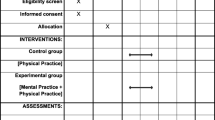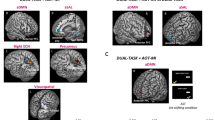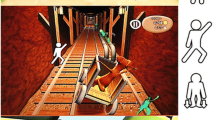Abstract
Gait disorders represent a therapeutic challenge in Parkinson’s disease (PD). This study investigated the efficacy of 4-week action observation training (AOT) on disease severity, freezing of gait and motor abilities in PD, and evaluated treatment-related brain functional changes. 25 PD patients with freezing of gait were randomized into two groups: AOT (action observation combined with practicing the observed actions) and “Landscape” (same physical training combined with landscape-videos observation). At baseline and 4-week, patients underwent clinical evaluation and fMRI. Clinical assessment was repeated at 8-week. At 4-week, both groups showed reduced freezing of gait severity, improved walking speed and quality of life. Moreover, AOT was associated with reduced motor disability and improved balance. AOT group showed a sustained positive effect on motor disability, walking speed, balance and quality of life at 8-week, with a trend toward a persisting reduced freezing of gait severity. At 4-week vs. baseline, AOT group showed increased recruitment of fronto-parietal areas during fMRI tasks, while the Landscape group showed a reduced fMRI activity of the left postcentral and inferior parietal gyri and right rolandic operculum and supramarginal gyrus. In AOT group, functional brain changes were associated with clinical improvements at 4-week and predicted clinical evolution at 8-week. AOT has a more lasting effect in improving motor function, gait and quality of life in PD patients relative to physical therapy alone. AOT-related performance gains are associated with an increased recruitment of motor regions and fronto-parietal mirror neuron and attentional control areas.




Similar content being viewed by others

References
Nieuwboer A, Giladi N (2013) Characterizing freezing of gait in Parkinson’s disease: models of an episodic phenomenon. Mov Disord 28:1509–1519
Vandenbossche J, Deroost N, Soetens E, Coomans D, Spildooren J, Vercruysse S, Nieuwboer A, Kerckhofs E (2012) Freezing of gait in Parkinson’s disease: disturbances in automaticity and control. Front Hum Neurosci 6:356
Nonnekes J, Snijders AH, Nutt JG, Deuschl G, Giladi N, Bloem BR (2015) Freezing of gait: a practical approach to management. Lancet Neurol 14:768–778
Buccino G (2014) Action observation treatment: a novel tool in neurorehabilitation. Philos Trans R Soc Lond B Biol Sci 369:20130185
Rizzolatti G, Craighero L (2004) The mirror-neuron system. Annu Rev Neurosci 27:169–192
Stefan K, Cohen LG, Duque J, Mazzocchio R, Celnik P, Sawaki L, Ungerleider L, Classen J (2005) Formation of a motor memory by action observation. J Neurosci 25:9339–9346
Buccino G, Gatti R, Giusti MC, Negrotti A, Rossi A, Calzetti S, Cappa SF (2011) Action observation treatment improves autonomy in daily activities in Parkinson’s disease patients: results from a pilot study. Mov Disord 26:1963–1964
Pelosin E, Bove M, Ruggeri P, Avanzino L, Abbruzzese G (2013) Reduction of bradykinesia of finger movements by a single session of action observation in Parkinson disease. Neurorehabil Neural Repair 27:552–560
Pelosin E, Avanzino L, Bove M, Stramesi P, Nieuwboer A, Abbruzzese G (2010) Action observation improves freezing of gait in patients with Parkinson’s disease. Neurorehabil Neural Repair 24:746–752
Giladi N, Shabtai H, Simon ES, Biran S, Tal J, Korczyn AD (2000) Construction of freezing of gait questionnaire for patients with Parkinsonism. Parkinsonism Relat Disord 6:165–170
Hoehn MM, Yahr MD (1967) Parkinsonism: onset, progression and mortality. Neurology 17:427–442
Folstein MF, Folstein SE, McHugh PR (1975) “Mini-mental state”. A practical method for grading the cognitive state of patients for the clinician. J Psychiatr Res 12:189–198
Beck AT, Ward CH, Mendelson M, Mock J, Erbaugh J (1961) An inventory for measuring depression. Arch Gen Psychiatry 4:561–571
Orsini A, Grossi D, Capitani E, Laiacona M, Papagno C, Vallar G (1987) Verbal and spatial immediate memory span: normative data from 1355 adults and 1112 children. Ital J Neurol Sci 8:539–548
Carlesimo GA, Caltagirone C, Gainotti G (1996) The Mental Deterioration Battery: normative data, diagnostic reliability and qualitative analyses of cognitive impairment. The Group for the Standardization of the Mental Deterioration Battery. Eur Neurol 36:378–384
Caffarra P, Vezzadini G, Dieci F, Zonato F, Venneri A (2002) Rey-Osterrieth complex figure: normative values in an Italian population sample. Neurol Sci 22:443–447
Novelli G, Papagno C, Capitani E, Laiacona N, Vallar G, Cappa SF (1986) Tre test clinici di ricerca e produzione lessicale. Taratura su soggetti normali. Arch Psicol Neurol Psichiatr 47:477–506
Abrahams S, Leigh PN, Harvey A, Vythelingum GN, Grise D, Goldstein LH (2000) Verbal fluency and executive dysfunction in amyotrophic lateral sclerosis (ALS). Neuropsychologia 38:734–747
Manos PJ (1999) Ten-point clock test sensitivity for Alzheimer’s disease in patients with MMSE scores greater than 23. Int J Geriatr Psychiatry 14:454–458
Caffarra P, Vezzadini G, Dieci F, Zonato F, Venneri A (2004) Modified card sorting test: normative data. J Clin Exp Neuropsychol 26:246–250
Monaco M, Costa A, Caltagirone C, Carlesimo GA (2013) Forward and backward span for verbal and visuo-spatial data: standardization and normative data from an Italian adult population. Neurol Sci 34:749–754
Spinnler H, Tognoni G (1987) Standardizzazione e taratura italiana di test neuropsicologici. Ital J Neurol Sci 6:1–120
Giovagnoli AR, Del Pesce M, Mascheroni S, Simoncelli M, Laiacona M, Capitani E (1996) Trail making test: normative values from 287 normal adult controls. Ital J Neurol Sci 17:305–309
Miceli G, Laudanna A, Burani C, Capasso R (1994) Batteria per l’Analisi del Deficit Afasico. B.A.D.A. [B.A.D.A. A battery for the assessment of aphasic disorders]. CEPSAG, Roma
De Renzi E, Faglioni P (1978) Normative data and screening power of a shortened version of the Token Test. Cortex 14:41–49
Mioshi E, Dawson K, Mitchell J, Arnold R, Hodges JR (2006) The Addenbrooke’s Cognitive Examination Revised (ACE-R): a brief cognitive test battery for dementia screening. Int J Geriatr Psychiatry 21:1078–1085
Fahn S, Elton RL, Committee motUD (1987) Unified Parkinson’s disease rating scale. In: Fahn S, Marsden CD, Goldstein M, Calne DB (eds) Recent developments in Parkinson’s disease II. MacMillan, New York, pp 153–163
Peto V, Jenkinson C, Fitzpatrick R, Greenhall R (1995) The development and validation of a short measure of functioning and well being for individuals with Parkinson’s disease. Qual Life Res 4:241–248
Franchignoni F, Velozo CA (2005) Use of the Berg Balance Scale in rehabilitation evaluation of patients with Parkinson’s disease. Arch Phys Med Rehabil 86:2225–2226 (author reply 2226)
Johnston M, de Morton N, Harding K, Taylor N (2013) Measuring mobility in patients living in the community with Parkinson disease. NeuroRehabilitation 32:957–966
Worsley KJ, Friston KJ (1995) Analysis of fMRI time-series revisited–again. Neuroimage 2:173–181
Tzourio-Mazoyer N, Landeau B, Papathanassiou D, Crivello F, Etard O, Delcroix N, Mazoyer B, Joliot M (2002) Automated anatomical labeling of activations in SPM using a macroscopic anatomical parcellation of the MNI MRI single-subject brain. Neuroimage 15:273–289
Maldjian JA, Laurienti PJ, Kraft RA, Burdette JH (2003) An automated method for neuroanatomic and cytoarchitectonic atlas-based interrogation of fMRI data sets. Neuroimage 19:1233–1239
Litvan I, Goldman JG, Troster AI, Schmand BA, Weintraub D, Petersen RC, Mollenhauer B, Adler CH, Marder K, Williams-Gray CH, Aarsland D, Kulisevsky J, Rodriguez-Oroz MC, Burn DJ, Barker RA, Emre M (2012) Diagnostic criteria for mild cognitive impairment in Parkinson’s disease: Movement Disorder Society Task Force guidelines. Mov Disord 27:349–356
Herz DM, Eickhoff SB, Lokkegaard A, Siebner HR (2014) Functional neuroimaging of motor control in Parkinson’s disease: a meta-analysis. Hum Brain Mapp 35:3227–3237
Snijders AH, Leunissen I, Bakker M, Overeem S, Helmich RC, Bloem BR, Toni I (2011) Gait-related cerebral alterations in patients with Parkinson’s disease with freezing of gait. Brain 134:59–72
Ertelt D, Small S, Solodkin A, Dettmers C, McNamara A, Binkofski F, Buccino G (2007) Action observation has a positive impact on rehabilitation of motor deficits after stroke. Neuroimage 36(Suppl 2):T164–173
Buccino G, Vogt S, Ritzl A, Fink GR, Zilles K, Freund HJ, Rizzolatti G (2004) Neural circuits underlying imitation learning of hand actions: an event-related fMRI study. Neuron 42:323–334
Gatti R, Tettamanti A, Gough PM, Riboldi E, Marinoni L, Buccino G (2013) Action observation versus motor imagery in learning a complex motor task: a short review of literature and a kinematics study. Neurosci Lett 540:37–42
Fox MD, Snyder AZ, Vincent JL, Corbetta M, Van Essen DC, Raichle ME (2005) The human brain is intrinsically organized into dynamic, anticorrelated functional networks. Proc Natl Acad Sci USA 102:9673–9678
Rowe J, Stephan KE, Friston K, Frackowiak R, Lees A, Passingham R (2002) Attention to action in Parkinson’s disease: impaired effective connectivity among frontal cortical regions. Brain 125:276–289
Vercruysse S, Gilat M, Shine JM, Heremans E, Lewis S, Nieuwboer A (2014) Freezing beyond gait in Parkinson’s disease: a review of current neurobehavioral evidence. Neurosci Biobehav Rev 43:213–227
Fasano A, Herman T, Tessitore A, Strafella AP, Bohnen NI (2015) Neuroimaging of Freezing of Gait. J Parkinsons Dis 5:241–254
Shine JM, Matar E, Ward PB, Frank MJ, Moustafa AA, Pearson M, Naismith SL, Lewis SJ (2013) Freezing of gait in Parkinson’s disease is associated with functional decoupling between the cognitive control network and the basal ganglia. Brain 136:3671–3681
Tessitore A, Amboni M, Esposito F, Russo A, Picillo M, Marcuccio L, Pellecchia MT, Vitale C, Cirillo M, Tedeschi G, Barone P (2012) Resting-state brain connectivity in patients with Parkinson’s disease and freezing of gait. Parkinsonism Relat Disord 18:781–787
Fling BW, Cohen RG, Mancini M, Carpenter SD, Fair DA, Nutt JG, Horak FB (2014) Functional reorganization of the locomotor network in Parkinson patients with freezing of gait. PLoS One 9:e100291
Wu T, Hallett M (2005) A functional MRI study of automatic movements in patients with Parkinson’s disease. Brain 128:2250–2259
Acknowledgments
We thank Dr. Elisa Pelosin for providing us with the video clips used during the training sessions. This study was partially supported by a grant from the Jacques and Gloria Gossweiler Foundation.
Author information
Authors and Affiliations
Corresponding author
Ethics declarations
Conflicts of interest
F Agosta serves on the editorial board of the Journal of Neurology; has received speaker honoraria from EXCEMED– Excellence in Medical Education; and receives research supports from the Italian Ministry of Health, AriSLA (Fondazione Italiana di Ricerca per la SLA), and the European Research Council. R. Gatti, E. Sarasso, M.A. Volonté, E. Canu, A. Meani, L. Sarro, M. Copetti, E. Cattrysse, E. Kerckhofs, and A. Falini report no disclosures. G. Comi has received compensation for consulting services and/or speaking activities from Novartis, Teva Pharmaceutical Ind., Sanofi, Genzyme, Merck Serono, Biogen, Bayer, Actelion, Serono Symposia International Foundation, Almirall, Chugai and Receptos. M. Filippi is Editor-in-Chief of Journal of Neurology; serves on the scientific advisory board of Teva Pharmaceutical Industries; has received compensation for consulting services and/or speaking activities from Biogen Idec, Excemed, Novartis, and Teva Pharmaceutical Industries; and receives research support from Biogen Idec, Teva Pharmaceutical Industries, Novartis, Italian Ministry of Health, Fondazione Italiana Sclerosi Multipla, Cure PSP, Alzheimer’s Drug Discovery Foundation (ADDF), the Jacques and Gloria Gossweiler Foundation (Switzerland), and ARiSLA (Fondazione Italiana di Ricerca per la SLA).
Additional information
F. Agosta and R. Gatti contributed equally to this work.
Electronic supplementary material
Below is the link to the electronic supplementary material.
Rights and permissions
About this article
Cite this article
Agosta, F., Gatti, R., Sarasso, E. et al. Brain plasticity in Parkinson’s disease with freezing of gait induced by action observation training. J Neurol 264, 88–101 (2017). https://doi.org/10.1007/s00415-016-8309-7
Received:
Revised:
Accepted:
Published:
Issue Date:
DOI: https://doi.org/10.1007/s00415-016-8309-7



